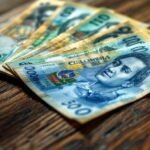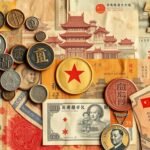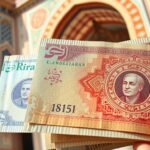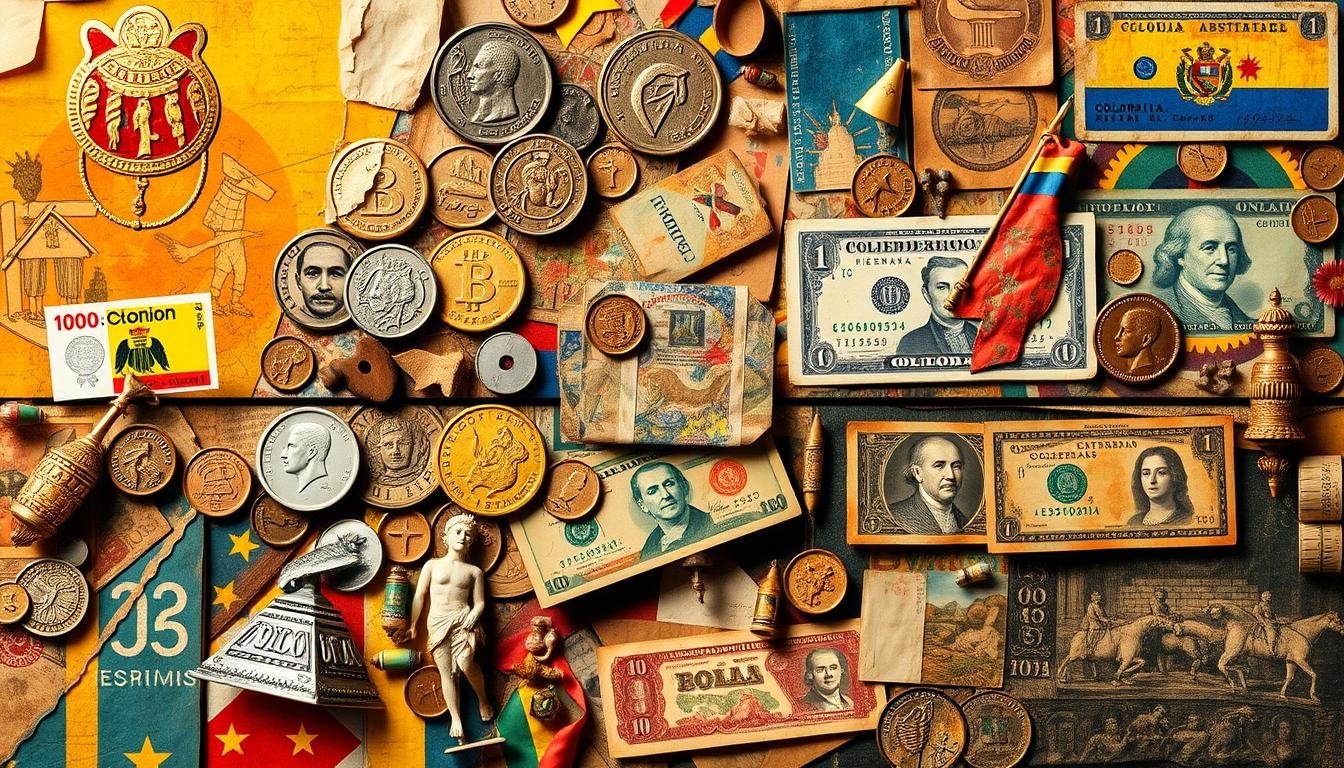
Exploring the history of Colombia’s currency reveals the Colombian Peso (COP) is split into 100 centavos, with common denominations starting at 50 pesos1. The journey of the Colombian currency is marked by growth and change. Initially, the peso’s exchange rate was pegged at 8 reals to 1 peso in 18101. Today, banknotes range from 2,000 to 100,000 pesos1. The 50,000 peso note stands out with its vertical print, unlike most currencies’ horizontal layout1.
The evolution of Colombia’s currency is deeply connected to the country’s economic progress. Colombia’s GDP has seen a near 7% growth rate in recent years1. The services sector now makes up over 50% of the GDP1. As you explore this history, you’ll uncover the significant events and milestones that have molded Colombia’s monetary system. This includes the introduction of the Colombian peso and its evolution over time.
Key Takeaways
- The Colombian Peso (COP) is the official currency of Colombia, with a rich history dating back to 18101.
- Colombian banknotes are available in various denominations, including 2,000, 5,000, 10,000, 20,000, 50,000, and 100,000 pesos1.
- The country’s GDP growth rate has reached nearly 7% in recent years, with the services sector comprising over 50% of Colombia’s GDP1.
- Colombia’s currency has undergone significant changes over the years, including the introduction of the 50 peso coin in 20121.
- The history of Colombia’s currency is a fascinating story of growth, transformation, and economic development, with the Colombian peso playing a vital role in the country’s economy1.
The Origins of Currency in Pre-Colombian Times
Exploring the Colombian monetary system reveals a rich history that has shaped the country’s currency and economy. The indigenous barter systems, established before European arrival, were foundational. They laid the groundwork for Colombia’s monetary system2.
Trade was the cornerstone of early exchange in Colombia, with tribes exchanging goods like food, clothing, and tools. The Spanish colonial period introduced new currencies and exchange systems, influencing the monetary timeline2. This period marked the beginning of a complex history of currency in Colombia.
The Colombian monetary system includes coins and banknotes, with the Central Bank of Colombia, known as Banco de la República, issuing them2. The peso is the current currency, reflecting the country’s economic evolution. Understanding this history is key to grasping Colombia’s current monetary system and its global standing.
The following table provides an overview of the Colombian currency:
| Denomination | Coins | Banknotes |
|---|---|---|
| 50 | X | |
| 100 | X | |
| 1,000 | X | |
| 2,000 | X |
The Colombian monetary system has seen many changes, with its economic history being a key factor. As you dive deeper into the Colombian currency timeline, you’ll uncover the complex history and its lasting impact on the economy2.
The Evolution of Colombian Currency Through Colonial Period
The Colombian financial system has seen major transformations, most significantly during the colonial era. The introduction of new coins and banknotes was key in shaping the country’s monetary policy3. The indigenous population, about one-third Chibcha at the Spanish conquest3, was deeply influenced by European colonization. The establishment of the audiencia of Santafé de Bogotá in 15493 also impacted the currency exchange rate.
The economic community backing the Creole officer corps was composed of wealthy landowners and merchants3. A rebellion by peasants and artisans at Socorro in 17813 was sparked by economic issues. Between 1785 and 1810, the Creole upper and middle classes began to seek political changes3. These developments significantly influenced the Colombian financial system, monetary policy, and currency exchange rate.
Today, Colombia’s population is around 53,485,0004, with a currency exchange rate of 1 USD = 3920.646 Colombian peso4. The country spans approximately 1,141,748 sq km4. The monetary policy and currency exchange rate are closely linked to the country’s economic health. This includes the gross national income (GNI) of 357,640 million USD4 and the GNI per capita of 6,870 USD4.
Birth of the Colombian Peso: Key Historical Milestones
The history of Colombia’s currency is a captivating tale that spans centuries. The Colombian peso has been a cornerstone in the country’s economic growth. Its evolution was influenced by the introduction of the first national currency and the Banco de la República’s establishment. The peso replaced the Spanish colonial real in 18375.
Initial monetary policies were vital in shaping Colombia’s economic trajectory. The peso’s history is dotted with key milestones, such as the introduction of paper money in the 1870s and Banco Nacional’s shift to fiat money in the late 19th century5. Various factors, including inflation and exchange rates, have shaped the peso’s evolution. For instance, the average annual inflation rate from 1971 to 2022 was 14.31%5.
First National Currency Introduction
The introduction of the first national currency in Colombia was a landmark event in its economic history. The peso replaced the Spanish real, with an initial exchange rate of 1 peso = 8 reales6. This marked the start of a new economic era, with the Banco de la República playing a key role in monetary policy.
Exploring Colombia’s currency history reveals the peso’s evolution was influenced by new coins and banknotes. Today, the peso is divided into 100 centavos, with banknotes available in various denominations5. The peso’s history is a rich narrative that continues to influence Colombia’s economy.
For more insights into Colombia’s currency history, visit the official Banco de la República website. It offers a detailed overview of the peso’s evolution, including its introduction and the Banco de la República’s establishment5.
The Complete History of Colombia’s Currency: From Independence to Modern Era
Exploring the Colombian monetary system reveals a rich tapestry of centuries. The timeline is dotted with key milestones, such as the first gold cobs in 16227 and the Bogotá mint’s gold production until 17567. The introduction of silver coins in 1627 marks another significant chapter in Colombia’s economic history7.
The journey of Colombia’s currency is filled with the introduction of new coins and banknotes. Between 1811 and 1815, the Cartagena Patriotic Council issued up to 300,000 pesos fuertes in notes7. The exchange rate of the euro against the Colombian peso on October 11, 2023, was 1 euro = 4,477.16 pesos8. The peso has seen major transformations, including decimalization in 1847 and the gold standard in 18718.
Today, the Colombian monetary system boasts a variety of banknotes and coins. As of 2023, six denominations of banknotes are in circulation: 2,000 pesos, 5,000 pesos, 10,000 pesos, 20,000 pesos, 50,000 pesos, and 100,000 pesos8. The $100,000 banknote, introduced on March 31, 2016, is made entirely of cotton fiber and features a predominantly green hue8. Understanding the Colombian currency timeline and economic history offers deep insights into the country’s monetary system and its evolution.
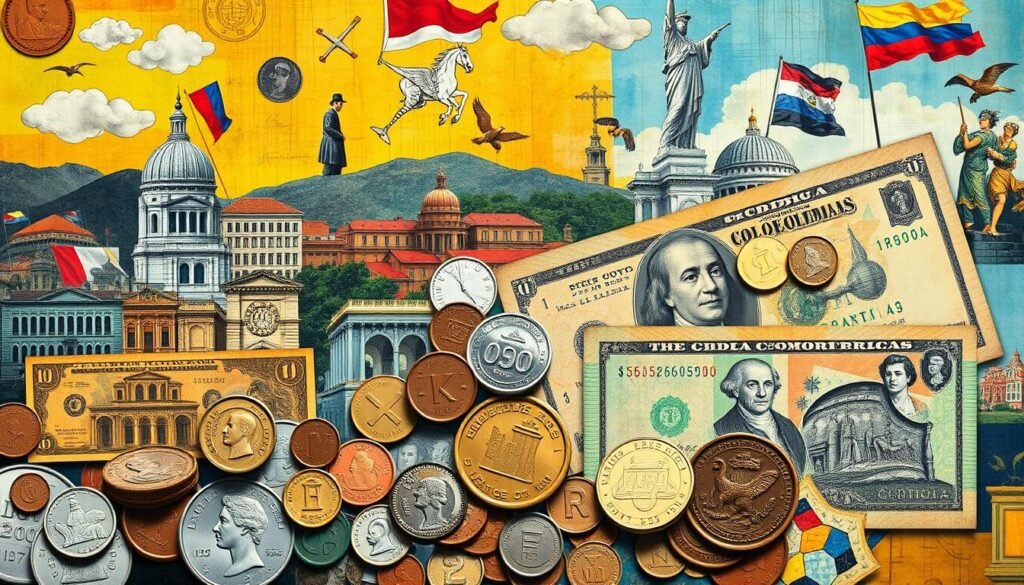
Significant Economic Reforms and Their Impact on Colombian Money
The Colombian financial system has seen major transformations, including a new tax system and the creation of a financial stability council9. These changes have positively influenced the monetary policy, fostering greater stability and control over the economy. Efforts to stabilize the Colombian currency exchange rate and promote international trade have also been made9.
Key policy shifts include deregulation of trade, capital, and labor markets, along with the strengthening of regulatory bodies9. This has spurred competition and innovation, removing barriers to entry in various sectors. The Central Bank has been restructured to effectively manage the expanding economic landscape9.
The effects of these reforms on the Colombian economy have been profound, with notable increases in economic growth and stability9. The country has become more appealing to foreign investors, attracting significant international trade9. The currency exchange rate has also seen reduced volatility, leading to more predictable economic conditions9.
| Year | Economic Growth | Foreign Investment |
|---|---|---|
| 2010 | 4.5% | $10 billion |
| 2015 | 3.5% | $15 billion |
| 2020 | 2.5% | $20 billion |
The Role of Banco de la República in Shaping Currency Policy
The Banco de la República has been instrumental in shaping Colombia’s currency policy, introducing new coins and banknotes10. Its policies have promoted financial stability and stability in the foreign exchange market. Exploring the history of Colombia’s currency reveals the Banco de la República’s significant impact on the evolution of Colombian currency.
Interest rates set by the Banco de la República attract foreign capital, strengthening the peso10. Changes in oil prices and US interest rates also influence capital flows, affecting the peso’s value10. The bank manages the money supply through open market operations, controlling inflation and stabilizing the peso10.
Understanding the Colombian peso history is key to grasping the current state of the currency. The Banco de la República’s efforts to maintain financial stability have been critical in shaping the history of Colombia’s currency. By examining the bank’s policies and their economic impact, you can better understand the factors influencing the Colombian peso’s value11.
The Banco de la República’s independence is vital for controlling inflation, as seen in Latin America12. This independence has a strong negative association with inflation, more pronounced in recent years12. As you explore the evolution of Colombian currency, it’s evident that the Banco de la República’s actions have been key in shaping monetary policy.
Digital Transformation of Colombian Currency
The Colombian financial system has seen major changes, focusing on digital transformation. This shift aims to enhance the monetary policy and stabilize the currency exchange rate. Electronic payment systems have been introduced, simplifying transactions for citizens13.
By 2019, about 75.3% of Colombians had internet access, mainly in cities13. This has led to the widespread use of digital payments, reducing the need for cash. The government has also launched efforts to boost financial inclusion and lower poverty, positively impacting the financial system14.
Cryptocurrency adoption is growing in Colombia, with businesses and individuals using them for transactions14. This trend has increased the use of digital wallets and electronic payment systems. As digital infrastructure develops, digital currencies’ use is expected to rise, possibly influencing the currency exchange rate13.
The Colombian financial system will likely evolve further, with a stronger focus on digital technologies. New electronic payment systems and cryptocurrency adoption are expected. The monetary policy will need to adjust to these developments, ensuring the currency exchange rate remains stable and the system secure13.
International Relations and Currency Exchange Dynamics
Exploring the Colombian monetary system reveals the importance of international relations and currency exchange dynamics. The timeline of the Colombian currency is shaped by economic indicators and geopolitical events15. Colombia’s diverse economy, with a wide range of trade partners, significantly impacts global trade.
The country’s economic history is marked by periods of inflation and economic challenges. Yet, Colombia has made significant strides in maintaining a stable economy. The Colombian Central Bank (Banco de la República) plays a key role in shaping monetary policy15. Its operational independence, granted in 1991, has allowed it to maintain the purchasing power of money and implement effective policies.
Colombia’s international trade is also influenced by its position as a significant exporter of coffee, ranking as the world’s third-largest exporter16. The country’s foreign market access has evolved, with Mexico and Cuba ranking second, and Brazil and Colombia ranking third16. Understanding these dynamics is essential for navigating the complexities of the Colombian monetary system and currency exchange dynamics.
| Country | Foreign Market Access Ranking |
|---|---|
| Mexico and Cuba | Second |
| Brazil and Colombia | Third |
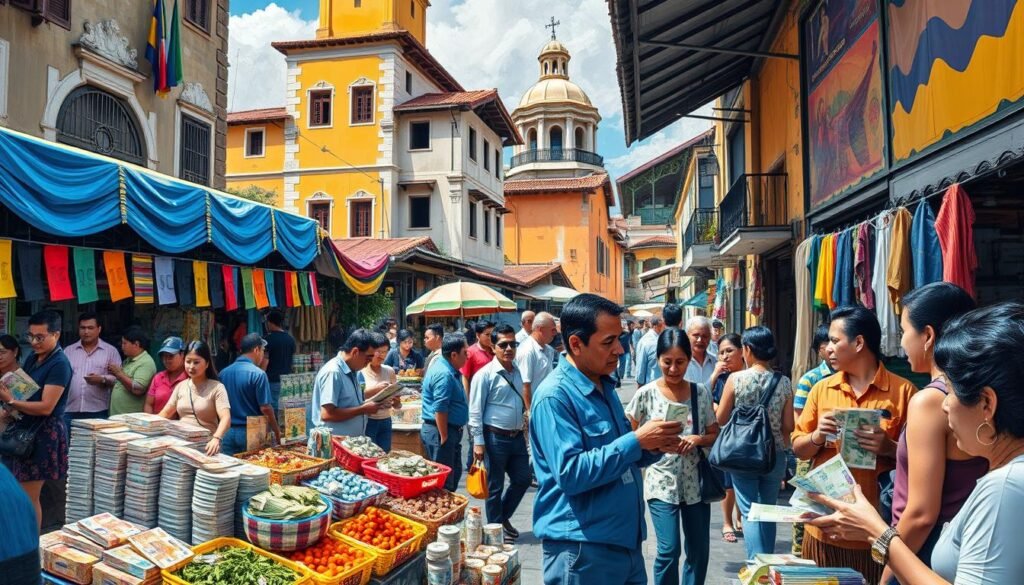
Modern Challenges Facing Colombian Currency
The history of Colombia’s currency is marked by significant fluctuations. Economic instability, corruption, and security concerns have all played a role in shaping the evolution of the Colombian currency17. The peso’s value has been influenced by various factors, including economic reforms and international trade18. Understanding the current state of the Colombian economy is vital. It helps grasp the challenges facing its monetary system, including the impact of economic instability on the peso’s history.
Key challenges for the Colombian currency include:
- Economic instability, causing significant fluctuations in the exchange rate17
- Corruption, which has eroded investor confidence and impacted the currency’s evolution18
- Security concerns, affecting the country’s ability to attract foreign investment and stabilize the peso’s history17
Despite these hurdles, the Colombian government has taken steps to stabilize the economy. They aim to promote the growth of the peso through policies to reduce inflation and boost foreign investment19. Grasping the history of Colombia’s currency and the factors influencing its value is essential for informed investment decisions.
| Year | Event | Impact on Colombian Currency |
|---|---|---|
| 2000 | U.S. Congress approved aid program | Significant decrease in crime rates, kidnappings, and terrorist activities17 |
| 2012 | Peace negotiations with FARC began | Improved investor confidence and increased foreign investment18 |
| 2018 | Presidential election | Largest voter turnout in about two decades, with Iván Duque finishing first17 |
Future Prospects for Colombia’s Monetary System
When looking at Colombia’s monetary system future, it’s vital to analyze the country’s economic outlook and policy shifts. The Colombian financial system is set to be a key player in shaping monetary policy, including the currency exchange rate. Recent data20 shows the economy has seen significant ups and downs, like a 4.2 percent GDP drop during the 1998-1999 financial crisis.
The monetary policy in Colombia has been shaped by several elements, like inflation targets and exchange rate regimes. The central bank, Banco de la República, aims to keep inflation between 2-4 percent15. It has also taken steps to build international reserves, like selling dollars through auctions of put options20.
Several factors will influence Colombia’s financial system and monetary policy:
- International trade agreements and Colombia’s global integration
- Policy changes, such as adjustments to inflation targeting
- Economic forecasts, including GDP growth and inflation predictions
The currency exchange rate will also be affected by these elements. It’s critical to keep an eye on these developments to grasp the future of Colombia’s monetary system15.
The future of Colombia’s monetary system hinges on both domestic and international factors. As Colombia deepens its ties with the global economy, it’s important to consider how this might affect its financial system and monetary policy20.
| Factor | Impact on Colombian Financial System |
|---|---|
| International trade agreements | Increased trade and investment, possible economic growth |
| Upcoming policy changes | Potential adjustments to inflation targeting, impact on monetary policy |
| Economic projections | Forecasts for GDP growth and inflation, possible effects on currency exchange rate |
Conclusion: Understanding the Legacy and Future of Colombian Currency
The history of Colombia’s currency is a fascinating story of growth, economic hurdles, and global interactions. It spans from ancient barter systems to the current Colombian peso. This journey has been influenced by various political, social, and financial elements21.
The future of Colombia’s currency is filled with both opportunities and challenges. The digital age and global economic ties demand that its monetary system evolves and stays ahead. This is essential for maintaining competitiveness and stability21.
The legacy of Colombia’s currency reflects its ability to endure, adapt, and strive for financial independence. As it faces the complexities of modern economics, it’s vital for leaders and financial bodies to learn from history. They must work towards a financially sound and prosperous future21.
FAQ
What is the history of currency in pre-Columbian Colombia?
How did the Spanish colonial influence impact Colombia’s monetary system?
What were the key historical milestones in the birth of the Colombian peso?
How has the Colombian currency evolved from independence to the modern era?
What were the major economic reforms that impacted the Colombian money system?
What is the role of the Banco de la República in shaping Colombia’s currency policy?
How has the digital transformation impacted Colombian currency?
How do international relations and currency exchange dynamics affect Colombia?
What are the modern challenges facing Colombian currency?
What are the future prospects for Colombia’s monetary system?
Source Links
- Colombian Peso (COP) – https://corporatefinanceinstitute.com/resources/foreign-exchange/colombian-peso-cop/
- 5 Fascinating Facts about the Colombian Peso – https://blog.remitly.com/currencies/colombian-peso/
- History of Colombia | Independence, Government, & Facts | Britannica – https://www.britannica.com/topic/history-of-Colombia
- Colombia | History, Map, Flag, Capital, Population, Currency, & Facts | Britannica – https://www.britannica.com/place/Colombia
- Colombia Currency (Colombian peso History + Facts) – WhiteboardCrypto – https://whiteboardcrypto.com/colombia-currency/
- Colombian peso – https://en.wikipedia.org/wiki/Colombian_peso
- Currency of Colombia – https://en.wikipedia.org/wiki/Currency_of_Colombia
- Colombian Peso (COP). Banknotes and notes. Peso rates – https://www.cambiator.es/en/colombian-peso/
- World Bank Document – https://documents1.worldbank.org/curated/en/103781468749727544/pdf/multi-page.pdf
- Colombian Peso: History, Exchange Rate, and Economic Impact – https://accountinginsights.org/colombian-peso-history-exchange-rate-and-economic-impact/
- PDF – https://bfi.uchicago.edu/wp-content/uploads/WP_2018-61.pdf
- No title found – https://www.elibrary.imf.org/view/journals/001/2022/186/article-A001-en.xml
- Digital Economy Strategy in Colombia: An Analysis and Recommendations – https://itif.org/publications/2020/11/30/digital-economy-strategy-colombia-analysis-and-recommendations/
- No title found – https://www.elibrary.imf.org/display/book/9781484375686/ch009.xml
- PDF – https://www.bis.org/publ/bppdf/bispap143_g.pdf
- Brewing Progress: An Exploration of The Historical Evolution, Economic Impact, and Globalization Dynamics of Coffee in Colombia – https://digitalcommons.bard.edu/cgi/viewcontent.cgi?article=1288&context=senproj_s2024
- Colombia – Peace, Economy, Culture | Britannica – https://www.britannica.com/place/Colombia/Colombia-in-the-21st-century
- Colombia’s next decade: Challenges and opportunities – https://business.cornell.edu/hub/2019/02/19/colombia-next-decade-challenges-opportunities/
- Currency information – https://colombia.travel/en/practical-information/currency-information
- Exchange Rate Policy and Inflation Targeting in Colombia – https://publications.iadb.org/publications/english/document/Exchange-Rate-Policy-and-Inflation-Targeting-in-Colombia.pdf
- PDF – https://scholar.harvard.edu/files/jrobinson/files/jr_colombia.pdf

